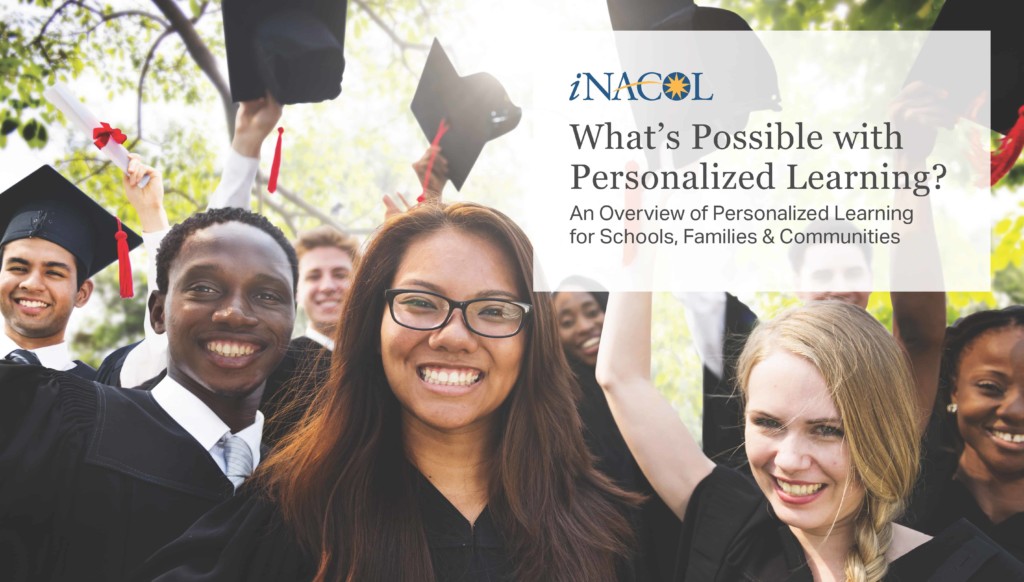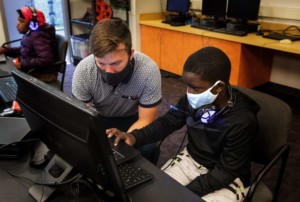New Personalized Learning Report for Parents and Communities

Teachers, leaders, students and families in communities across the country are coming together to explore how schools can better prepare students to succeed after graduation.
Together, they’re exploring big questions such as:
- What must students know and do to be able to thrive in the modern world?
- What learning experiences are necessary to ensure students graduate with these skills and traits?
- How do schools better meet the needs and interests of students by providing personalized pathways toward graduation?
- How must schools transform in order to create these new learning experiences and opportunities?
When schools and districts engage their communities in conversations about these questions, the answers they reach often have much in common aimed at increasing access to high-quality learning and addressing equity. In cities across the United States, urban, rural and suburban communities, families and community leaders are examining the promise of personalized learning to better educate all students and to better equip them to thrive in college, career and life.
In the diverse and ever-changing world of education, the term “personalized learning” seems to be everywhere, though there is not yet a shared understanding of what it means. Authored by Bruce Friend, Susan Patrick, Carri Schneider and Tom Vander Ark, this paper seeks to clarify what personalized learning is and is not and what it looks like for teachers and students.
Personalized learning tailors learning to each student’s strengths, needs and interests. Students have “voice and choice” in determining what, how, when and where the learning occurs. Teachers provide the flexibility and support to ensure mastery of the highest standards possible.
A new report from iNACOL titled “What’s Possible with Personalized Learning?” is designed to help families and communities understand the potential of personalized learning through real-life examples in schools across the country. The guide is written with a parent and community audience in mind and aims to empower readers with a deeper understanding of what these approaches look like and mean for helping to support and meet students’ needs in schools.
Specifically, the iNACOL report defines and describes personalized learning and illustrates what personalized learning looks like in practice from student and teacher perspectives at the classroom and instructional levels. These real-life examples also help readers understand the potential of personalized learning to improve student outcomes, increase opportunity and address current myths about personalized learning.
What Does Personalized Learning Mean for Students?
To put it simply, personalized learning means that each student will have his/her learning needs met. Personalized learning classrooms may look and feel different for today’s students than they did when their parents were in school, but students are likely to understand the changes. In fact, many schools shift to personalized learning because of community conversations with students and their families who share their frustrations with the current system and want to see a new approach put into place. In other words, because students stand to gain the most from the shift to personalized learning, they are typically the biggest advocates for these changes.
Students are excited about personalized learning for these reasons:
- Students have a say in their learning.
- The individual needs of each student are met, so each student is successful.
- Students have a clear understanding of their learning goals and know how to achieve them.
- Students get to make choices about how they “show what they know.”
- Students get the support they need when they are challenged by a concept.
- Students get the encouragement they need when they are ready to move forward.
What Does Personalized Learning Mean For Teachers?
Good teachers have always attempted to match their teaching to the unique needs of each student—by offering options to dig deeper into an assignment for advanced learners or by offering additional support or a modified assignment to struggling learners. Yet, a teacher trying to personalize learning with a single textbook for a full classroom of 20 to 30 students has been very challenging for every student, every day. Until now. Thanks to new school designs, teachers can now provide every learner with powerful, personalized learning experiences. Teachers find this empowering and motivating. In personalized learning models, their professional expertise is valued and respected. In fact, many teachers explain that one of the biggest benefits of personalized learning is that they can “get back to the reason I became a teacher.”
Teachers are excited about personalized learning for these reasons:
- Teachers form stronger relationships with students because they get to spend more time getting to know them and their strengths, goals and interests.
- Teachers focus on research around how students learn best.
- Teachers have more time each day where they can communicate and collaborate with one another, asking questions and figuring out what’s working and not working.
- Teachers get to be more creative in how they design curriculum and instruction.
- Teachers get more time working individually and in small groups with students.
- Teachers spend less time preparing students for high-stakes tests and more time acting as guides and mentors to students as they are learning.
- Teachers get to help students to better understand themselves and their goals for the future.
- Teachers have more opportunities to develop their own skills as teachers and to work in collaboration with other teachers.
In addition to describing in detail what personalized learning means for students and for teachers, the report ends with a set of recommendations for parents and communities.
How Can Families and Communities Support Personalized Learning?
There are many ways that families and communities can support personalized learning, whether their school or district is just getting started with exploring the “big questions” at the start of the report or whether they are many years into implementing these new practices.
- Ideally, families and communities will have opportunities to be involved in the early phases of the shift to personalized learning and as new ways to teach and learn are put into practice.
- Families can change the way they talk about learning with their kids. For example, parents are engaging their children in conversations about what they are curious about, how they like to learn best, what their interests are, how they have learned from a recent failure, and so on. In other words, the emphasis should be on the process of learning and not just the end grade.
- Families and communities are working together to inform what changes are occurring in schools frequently by attending community outreach events, parent information nights, providing ongoing feedback in online surveys, sending emails, mentioning concerns to teachers or leaders and sharing their ideas.
- Families can take advantage of new learning opportunities when schools personalize learning by offering ways to learn more connecting within the community, in internships, after school programs, museums and beyond.
Realizing The Potential of Personalized Learning
There are a lot of reasons that schools and districts are changing from the traditional way of doing things to more personalized learning models. These changes are underway as a response to local, regional and global challenges as well as the big opportunities that now exist to do for students what teachers have always wanted to do—give learners the support and encouragement that they need to truly excel and thrive.
“What’s Possible with Personalized Learning?” is a resource for schools and communities who want to help demystify the changes underway.
While there is much promise in the potential of personalized learning, we are a long way from ensuring that every student’s experience is a personalized one. We must each do our part to make the vision for powerful, personalized learning a reality for every student.
To download the full report click here.
For more, see:
- Mean What You Say: Defining and Integrating Personalized, Blended and Competency Education
- What Is Personalized Learning?
- Getting Started with Personalized Learning: Resources for Education Leaders, Teachers and Policymakers
Stay in-the-know with all things EdTech and innovations in learning by signing up to receive the weekly Smart Update. This post includes mentions of a Getting Smart partner. For a full list of partners, affiliate organizations and all other disclosures please see our Partner page.





0 Comments
Leave a Comment
Your email address will not be published. All fields are required.